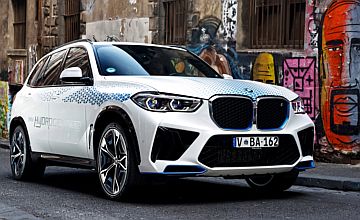2024 BMW iX5 FCEV Hydrogen Prototype Review

Overview
REGULAR readers of these pages will be familiar with the fact BMW is currently touring its iX5 FCEV (fuel cell electric vehicle) Hydrogen prototype on something of a global fact-finding mission.
In Australia this month, a pair of the models were offered to local journalists for a very quick lap of the former Holden Proving Ground in Lang Lang, Victoria to sample the car for ourselves.
While a handful of clicks was hardly a thorough opportunity to test the car in real-world conditions, it was sufficient to discover just how close the vehicle feels to a comparable electric model, albeit with a little less weight, and a little more tech on board.
Developed in collaboration with Toyota, whose Mirai-sourced fuel cell stack provides the prototype with its electric power, the BMW iX5 Hydrogen can produce up to 295kW of motive power alongside a very useful 504km of driving range (WLTP).
BMW Australia has taken delivery of two iX5 Hydrogen FCEVs for local testing and events to underline the everyday usability of hydrogen-powered transport.
The vehicles, built as part of a pilot series, are fully functional and have already covered thousands of kilometres of testing, taking part in drive programs in Europe, Japan, South Korea, China, the United States of America, the Middle East, and South Africa.
BMW says the global test program has been designed to gain important information and knowledge for the development of a potential series-production FCEV model.
At this stage, the iX5 Hydrogen FCEV will provide support on a regional level for the development of infrastructure that can be used with the model’s 700bar refuelling technology – a technology present in many other hydrogen-powered cars, buses, trucks, and utility vehicles.
The Australian leg of the BMW iX5 Hydrogen pilot vehicles’ global tour will enable the BMW Group to gain further knowledge and data as part of its fact finding and feasibility study that may help support the move toward hydrogen powered vehicles in the future.
The car itself looks (and to be honest, drives) just like what you would expect an electric-powered X5 to look and drive like. A gauge might be different here and some badging there, but it is otherwise a road-going vehicle that is as simple to operate and refill as any other.
BMW says the model is good for over 600km range on a single fill, which should take around three- to four minutes. Find yourself a charging station, and it’s no harder that using an LPG coupling. Click, squeeze, done.
Driving Impressions
Very quickly, the iX5 FCEV Hydrogen works by converting hydrogen stored in a trio of carbon-fibre tanks (6kg in total) at a pressure of 700bar through a chemical reaction chamber (or cell) to produce electricity which in turn fills a battery and/or drives the motor.
Like other EVs this can be added to from regenerative braking – but unlike other EVs cannot be supplemented by connection to a plug and socket. This system is pure H2, which as we can see it is the only shortfall in an otherwise resolved package.
The only emissions are water vapour and heat, the latter captured to warm the battery or cabin as required.
Hit the blue ‘on-off’ button and there’s no sound. Just a flicker of the instrument panel to tell you that you’re ‘ready’ to drive. Unlike the internal combustion hydrogen Toyota HiAce we drove last year, there is no waiting, and no noise. Just select Drive and away you go.
The iX5 accelerates smoothly, like any electric vehicle, and hustles briskly to 100km/h. The lower weight (around 100kg less to what we estimate at 2500kg kerb) ensures triple digits are reached in just under seven seconds, the acceleration thereafter as effortless and steady as any BMW ‘i’ model we’ve sampled.
Like those models, this ‘prototype’ is refined and smooth, with absolute silence accompanying our single loop of the Lang Lang ride and handling course. The suspension is quite supple, and the body control impressive, the iX5 FCEV Hydrogen carrying itself with the kind of demeanour we’d expect of a fully-fledged production model.
Steering is typically BMW: light and engaging. It communicates well the intentions of the front-end and feels just right for the application that is a family car. Couple this with a smooth regenerative braking action and effortless service brakes and it really is very hard to discern that this ‘prototype’ model is just that, and not a showroom-ready vehicle.
Look closer and the blue garnishing and etched dashboard cover might give things away. There are also a couple of unique badges around the vehicle and 22-inch alloys we can’t recall spotting anywhere else. Likewise, there is no compromise in interior space, the tanks tucked safely beneath the floor occupying much the same space a BEV car’s battery might.
As we’ve stressed earlier, our drive of the BMW iX5 FCEV Hydrogen was very brief, but also very convincing. If this kind of technology is available now, and capable of delivering the kinds of environmental benefits BMW spruiks, then there is no reason we can see that infrastructure providers should not be acting to make hydrogen fuel-cell technology part of the ‘mix’.
To our eyes, the technology is far better suited to the needs of most Australian drivers and with fewer of the penalties associated with pure electric vehicles (larger and heavier batteries, slow charging, expensive infrastructure and grid requirements, greater quantities of rare materials, and so on…).
If we are this convinced after one short drive, we hope others will be too – including those BMW hopes to influence on this tour.
We wish them the very best of luck.